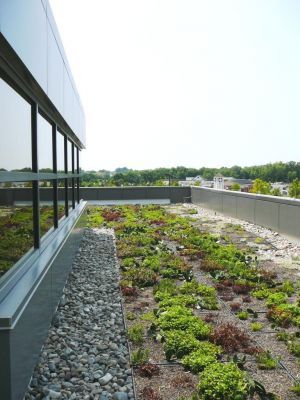 Most people consider a green roof a topper using sustainable materials. In actuality, green roofs are a span of living plants and grasses atop a house or commercial building. In a sea of bleak black, the green roof is a return to nature, a mitigating force for different species of birds and insects. Where man has built, birds, butterflies and insects have lost their habitat. Green roofs not only provide beauty, but they return to exiled species their rightful milieu.
Most people consider a green roof a topper using sustainable materials. In actuality, green roofs are a span of living plants and grasses atop a house or commercial building. In a sea of bleak black, the green roof is a return to nature, a mitigating force for different species of birds and insects. Where man has built, birds, butterflies and insects have lost their habitat. Green roofs not only provide beauty, but they return to exiled species their rightful milieu.
Awareness of the unfortunate species isn’t only where green roofs stop. Awareness is being raised of their effect on greenhouse gases and pollution, their effect on the carbon footprint left by heat and cooling systems and their effect on the quality of life for inhabitants of a home topped by a green roof. Yes, the initial cost of laying the roof will be expensive, but the savings will be both immediate and substantial. Add to this the health benefits of a green roof, and homeowners with asthmatic family members will ask where to sign. But even this isn’t the rest of the story.
Water Quality
Plants filter pollutants from rainwater. The Environmental Protection Agency, or EPA, says that green roofs return cleaner water to the storm runoff drains. Water crossing parking lots and roads contain oils and other chemicals. Water absorbed into the ground contains lawn fertilizers and other chemicals, pet waste and bacteria. All that flows into the stormwater drains. Some is filtered out, but sometimes the sheer volume of water can not only cause flooding and the destruction of natural habitats, but the pollutants can overpower the filtering process. The sum of these problems is the poisoning of water downstream in addition to natural habitats. Green roofs can help.
Reduction of Heat Islands
The EPA describes a heat island as an area that is built-up or industrialized that is warmer than the countryside around it. A heat island can be one to five degrees warmer than its rural cousins. This means more air conditioning, more air pollution, greenhouse gas emissions and heat-related diseases or illnesses. Green roofs cancel out heat absorbed into black asphalt roofs. There will be no need for more and more air conditioning, thereby reducing the heat island effect.
Is Your House Right for a Green Roof?
That will take an expert to tell you. For example, homes with flat roofs are perfect for green roofs. Obviously, commercial enterprises with flat roofs would work. Those homes, however, with a pitch of over 30 degrees will need an expert’s advice. A very real worry is if the structure will support a green roof. Most county building inspectors are structural engineers, and they can tell homeowners, often free of charge, what needs to be done. The components of a green roof are:
- Weatherproof membrane. This seals the roof off from potential water damage.
- Root protection barrier. This will be inorganic, due to its inability to rot and its inability to absorb plant roots.
- Drainage layer. This prevents roof leaks and keeps the plants from drowning. It is also a major concern to the structure, because most drainage layers are made from pulverized brick, sand, clay or gravel.
- Growing medium. On flatter roofs, this could encompass trees and bushes. On pitched roofs, this could include ground cover, grasses and flowers.
There is much to understand about a structure, from load to wood species. Before construction, the homeowner should also know how the square footage of the plants affects the roof. A do-it-yourselfer, if properly trained in carpentry, could pull off a green roof without it falling on top of him. Anyone else should seek the advice of a professional. Green roofs do so many good things for so many people.
